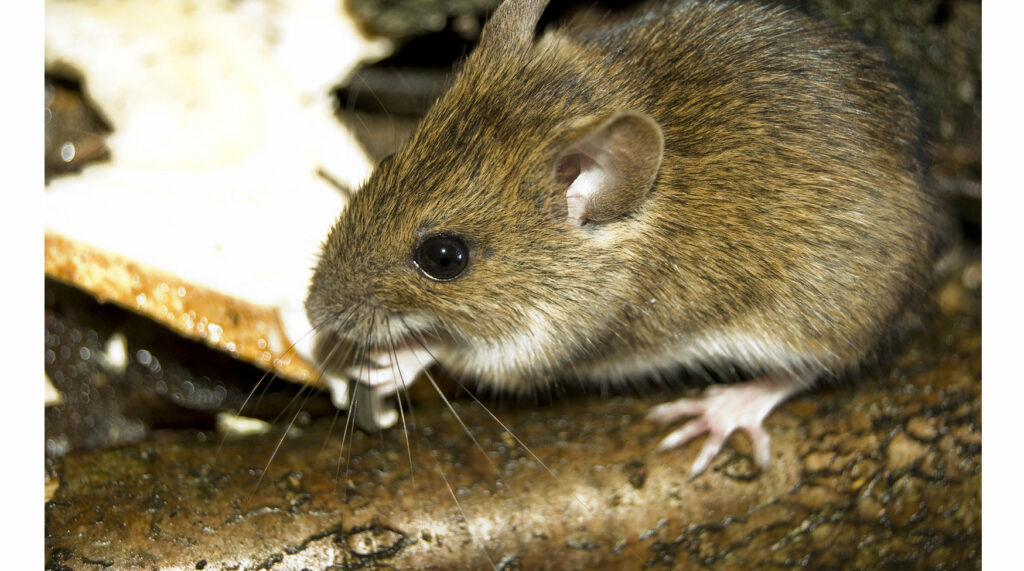Controlling mice requires very thorough exclusion methods. To protect your pets and family, you should also use poisons that don’t pose a secondary risk to your pets or children. The team at Safer Nature talks about all of these points in this podcast.
John Maher: Hi, I’m John Maher. I’m here today with Ryan Potts, founder and owner of Safer Nature Pest Control, and Matt Raftery, Manager of Operations, specializing in traditional and organic pest control services in Massachusetts. Today our topic is mouse control in Massachusetts. Welcome, Ryan and Matt.
Ryan Potts: Thank you, John. Thank you for having us.
Matt Raftery: Good morning. Thanks for having us, John.
Signs You Have Mice in Your House
John: Yeah. What are some signs that you have mice in your home?
Ryan: Typically, what we get calls on are customers complaining they’re seeing droppings, whether it be under a sink or on the counter, sometimes just scratching noises in the wall in a particular area. Then, we come out. First and foremost, we’ll do an inspection for them. We’ll identify clearly if it’s a mouse making that noise and identify the droppings. Typically, we’ll find this time, in Massachusetts, it’s either the brown house mouse or the white-footed mouse. White-footed mouse is much more elusive. They’ll be typically up high in the attic space. It’s a different sound. I mean, you can-
Matt: Yeah, almost a hopping sound that you can hear. Sometimes it’s faint, depending on the level of insulation you have.
John: Okay.
Using Droppings to Identify Mouse Species
Ryan: Yep. They’re much more elusive. Again, we can also tell with the droppings and identify that species. You’re going to see mice tunneling in the attic. Again, I identify any nesting points in that attic. But what we’re doing… We come to the person’s home, obviously, asking where they’re seeing the droppings. We investigate those areas.
Then, we go around the interior, the attic, basement, and then all around the main living space to identify what species it is. Brown house mouse or the white-footed mouse. Then, go around the whole entire structure on the exterior. We’re going to identify any points of entry around the exterior of the house. Most of the time, depending on the style of foundation… In New England, a lot of the older homes… Clearly, fieldstone foundation is very problematic with mice. You can just keep going with that one.
Excluding Mice From the Home
Matt: Sure. Another dead giveaway… A lot of times, the main entry point is at the sill level of where the structure of the house/the wood framing meets the foundation. From a basement perspective, you can see sometimes along that concrete lip of the sill we call. You’ll see either bits of insulation or droppings. Any insulation manipulation or tunneling is really easy for us to spot. Sometimes homeowners don’t recognize it.
But mice can also climb. They’re avid climbers. Whether it’s vinyl or wood trim boards, we’ve seen mice be able to go right up into attics with no basement activity. They usually need some type of channel or something to grab onto to get up that high. But really, the space the size of a dime is all they really need to get in. It can be a bit of a challenge to exclude that. Certainly with a more modern house, with a poured concrete foundation, as long as we have access to all the points surrounding the house, we’re generally able to do a pretty good job of excluding them once we’ve eliminated them from being in the home.
Dangers of Mice in Your Home
John: Are mice in the house dangerous? What’s the main reason for wanting to get rid of them?
Matt: Well, yes, bacteria and germ carriers. There’s one specific rodent disease, the hantaviruses that they’re known to carry. But mice are also capable of moving a whole plethora of other household viruses, whether it be rotavirus. Generally, their droppings are just… They’re not something you want going through your food/going through your living spaces, especially your eating spaces, utensils, cookware. They’re definitely been known to spread disease. It’s something that’s been plaguing civilization ever since we’ve been civilized, I suppose, you’d say.
John: Yep.
Ryan: Yep.
Strategies for Removing Mice From Your Home
John: What are some lethal and maybe non-lethal methods for removing mice?
Ryan: You can use a traditional product, rodenticide. There’s second-generation. There’s first-generation. But we also offer, again, that organic aspect where we set up tamper-resistant stations. We bait with certain target-specific mice traps. It’s very conducive. They go into these stations. They’re organically baited. Go into the trap. The food source is there. It’s all 100% organic. It’s very time and labor-intensive-
Matt: It is.
Ryan: …for us. But it really does work. That’s the thing. That’s the thing. We set up these baits… They’re organic bait stations on the traps. We can see in particular areas that we set them up strategically, in the basement or in the attic, where they’re entering that structure, so wherever we set these guys. We’re getting all that activity. We’re getting a bunch of mice in those stations. That’s going to lead us towards the entry points. It really does. It works.
Again, it’s much more intensive on our end in terms of traditional products we’re using. What we find is that works excellent as well. If you have a major infestation, we’re using tamper-resistant bait stations there. That’s a traditional product. We’re going to set those bait stations up strategically where we see mice trailing. Mice tend to leave rub marks on their skin. It looks like a grease mark on a wire where they’re really starting to make a highway. That’s it. They’re following a pheromone. One mouse goes in, and the rest of them follow. Over time, you could start to see a lot of rub marks. We’re going to set up those stations, identify all those points of entry, and set those stations up strategically.
With that product, you’re looking at seven to 10 days. You might see an influx of activity in the first three or four days. We always advise customers of that. It’s like a new food source. They’re going to be all excited. But the thing is with that product we’re using there is it’s a traditional product. But seven to 10 days… Really wiping out that population. We’re coming back there again in two weeks’ time as a follow-up. It’s all included in our costs. All our services are warrantied. We want to make sure that when we come back, we’re going to remove any dead mice that are there.
Again, everything we’re using is tamper-resistant. When I say that, I mean you need a special key to get into it. We’re always abiding by the label. We screw everything in. There’s nothing that can ever be moved. You need a special key to get into these stations that we only have.
We come back in that two-week timeframe, see where all the mice have been feeding on those stations the most. It directs us towards our entry points. We go around that exterior. We start closing off mice-size entry points at that time. Typically, even with that warranty service, we rarely ever get callbacks for that service. I mean, it’s highly effective. We have designed a program that’s very effective in the sense that once we come back after that two-week timeframe, there’s no extra cost in that at all.
We’re closing off those mice-size entry points. If there’s anything larger in size, we most certainly going to advise you guys on the customer itself if they need further work, say, a mason or something. We’re talking large gaps. But we’re going around identifying those points of entry, mice-size entry points, closing those off, and getting rid of that population. The customer’s happy. Great results there.
Environmentally Friendly Mouse Removal Methods
John: Are there environmentally-friendly mice removal methods if people are concerned about, say, using a rodenticide? Then, I’ve heard of cases where maybe there might be a bald eagle, say, that will grab one of the mice that now has that poison in it, and then that affects the bald eagle. Or maybe you have pets. Maybe you have cats in the house or something like that, and you’re concerned about poisoning the mice and then poisoning your pet. How do you deal with that situation?
Ryan: Yeah, absolutely. Again, we have the organic option that we talked about. That’s organic baiting and trapping, removing them, obviously, no issue or any concern with that, with any secondary poisoning. Then, even with the traditional products we use, in all the years we’ve been a business, we’ve never had-
Matt: We’ve never had secondary poisoning.
Ryan: Never once.
Matt: That’s something I’m very… If you have a pet that you know would gulp down a dead mouse or a dying mouse or rodent of any sort, it’s what’s undigested in their gullet and in their stomach that would be of a concern. The materials we use are not… There’s not enough potency if they were eating just one or two mice. It wouldn’t be enough to affect them. We’re very conscientious. There are some very high-potency products out there where the dose is what we deem to be unsafe. We never use. We’ve seen other-
Ryan: We don’t use those.
Matt: Yeah. We’ve seen other companies out there that… They want immediate knockdown. They are effective. But it’s, in our opinion, too dangerous and hasa secondary poisoning risk. We try to avoid that-
Ryan: At all costs.
Matt: …at all costs.
Ryan: Yep.
John: All right. Any final thoughts on mouse control?
Safe Mice Extermination Methods
Ryan: I think if anything, again, with our service, what we’re doing is we are very thorough in respect that we’re going around that entire structure. We’re doing mice exclusion, mice-size entry points. That’s specialized in the sense a lot of companies won’t do that. That’s all included in our service. Again, we want to give the customer the best possible result and experience working with us so we have a long-lasting relationship. Again, that’s our main concern. Child/pet safety… Most certainly, again, 100% our main concern. That’s what we do.
John: All right. Well, that’s really great information. Ryan and Matt, thanks again for speaking with me today.
Ryan: Thank you, John. Thank you for having us.
Matt: Thanks, John.
John: For more information, you can visit the Safer Nature website at safernature.com or call 978-325-1325.


